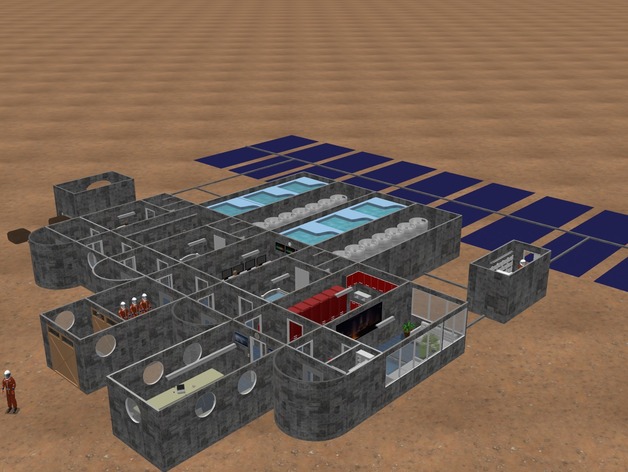
Mars Base
thingiverse
This represents the plans for a longterm Mars base to support 6 people. Assembly The construction of this base will require 15 to 18 launches of heavy lift rocket supporting a payload fairing of 10 meters high by 4 meters wide. The rocket will also need to be able to support up to 8000 kilograms of payload to Mars. The base will be composed of several robotic mobile modules. Once all of them have been delivered to Mars, they will begin pairing up and constructing themselves according to a predetermined layout. Each module will use an interlocking docking mechanism to connect to the other modules. The docking connector will also act as a distribution mechanism for networked resource tubing(NRT) such as water, waste,electricity, O2 and CO2. The walls of each module generally consist of 8cm thick titanium carbon nanotubes with exception of NRT's which account for over half of the overall thickness in some areas. Living Conditions Two astronauts will be assigned to share a room module. Each room module will consist of a bunk bed, lavatory and shower. The astronauts will also share a small closet for storing clothing and other personal things. Adjacent to each room will be an emergancy evacuation closet. This closet will be pressurized and provides two space suits and weeks worth of rations. In the event of a hull breech astronauts will be able to quickly get suited up and assess any potential problems without having to go to the air lock. Command The command module will consist of 3 large wall displays showing statistics about the base and 8 computer units for checking more detailed stats and for doing diagnostics. Lounge The lounge module will be a place for taking a break and socializing. It will also have a television that shows latest information and entertainment from earth. Food The kitchen module will house 12 industrial strength refrigeration units capable of storing up to 1000 individual frozen meal packets. There will also be an additional 1000 MRE meals for emergency use. The hydroponics module will be used to grow genetically modified fruits and vegetables using high grade artificial grow lights. Air and Water The base will be filled with a nitrogen/oxygen atmosphere. CO2 will be sent to Hydroponics and O2 will be replenished using the plants or from the electrolysis module. Two water modules will be sent holding 50,000 gallons of water. Each module will have a waste container and water recycle unit. If the base is situated near the poles then robotic gatherers with on-board lasers can obtain ice chunks and return them to base for recycling also. Excess water can further be broken down into Oxygen (air) and Hydrogen (fuel cells) using the electrolysis module. Sandstorms and Radiation In addition to thick titanium plating used in the base there will also be a large scale 3D printer sent to Mars, whose sole purpose is to create 3D blocks from Mars soil. This factory will consist of a conveyor belt and 2 robotic helpers. Their purpose will be to encapsulate the entire base with 1 meter thick bricks created from martian soil, to protect against radiation and sand storms. An added benefit of the factory is that it also produces water from the soil during the brick making process, which can be sent to the water recyclers. Transportation Five two-passenger vehicles will be provided for exploration. These vehicles will be battery powered with a maximum range of 400 km and a total speed of 50km/h. The range can be greatly extended if a deployable solar panel or RTG charging unit is brought along. Power The main source of power during the day will come from 10 solar panels with a total area of 40 square meters each (400 square meters total). During low light scenarios (night time, sandstorm) power will be provided by several large scale radioisotope thermoelectric generators (RTGs) and hydrogen powered fuel cells. For safety and ease of service a power module will be sent to house the RTG, fuel cells and transformers. Small robotic vacuum cleaners (similar to the ones on earth) will be used to clean the solar panels daily.
With this file you will be able to print Mars Base with your 3D printer. Click on the button and save the file on your computer to work, edit or customize your design. You can also find more 3D designs for printers on Mars Base.
